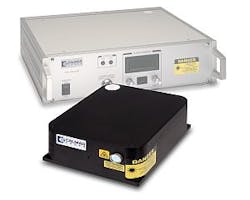
The Mendocino 780 nm laser features a pulsewidth less than 0.1 ps and pulse energy greater than 1 nJ at 50 MHz with average output power greater than 50 mW. The all-fiber 10 mW/780 nm laser measures 19.7 × 12.7 × 7.0 cm3 and runs from a 5 V supply. The 50 mW/780 nm fiber laser head is 15.2 × 12.7 × 6.0 cm3, and requires a driver supply at 34.0 × 30.0 × 9.0 cm3. The laser is also available in a benchtop or rack-mount configuration for laboratory use.
Calmar Laser
Sunnyvale, CA
www.calmarlaser.com
------
PRESS RELEASE
New Mendocino all-fiber laser generates 50 mW of 780 nm ultrafast pulses.
The innovative all fiber laser design results in a compact and rugged package.
Pulse width is < 0.1 ps and pulse energy is > 1nJ at 50 MHz with average output power > 50 mW. Optional higher power output to 500 mW will be available soon.
The unique all-fiber design of Calmar’s Mendocino 780 nm laser naturally provides excellent stability and reliability in harsh environments and long term use, important for OEM applications. The all-fiber design also allows our laser to be many times smaller than most other solid state or fiber lasers. Calmar’s 10 mW 780 mW laser is only 19.7 x 12.7 x 7.0 cm3 and runs from a 5 V supply. The 50 mW 780 nm fiber laser head is 15.2 x 12.7 x 6.0 cm3, and requires a driver supply at 34.0 x 30.0 x 9.0 cm3. (Smaller drivers are possible on request.) The laser is also available in a bench top or rack mount configuration for laboratory use.
Our 780 nm laser is a second harmonic generation (SHG) product of Calmar's passively mode-locked fiber laser in the C-band. Calmar’s seed laser uses a proven semiconductor saturable absorber approach and polarization maintaining fiber. The semiconductor saturable absorber ensures consistent and reliable start of mode-locking. The steady laser pulse output characteristics are actually determined by soliton effects of fiber laser cavity. Since fiber gain, dispersion and nonlinear effects are very stable over time, temperature, and other external disturbances, our seed laser output is very stable. In contrast, some of our competitors use nonlinear polarization rotation design, which is intrinsically sensitive to temperature, time, and other external disturbances.
Fiber optic technology enables Calmar Laser to produce highly reliable compact lasers with short pulse width, high peak power, and excellent beam qualities. Fiber lasers have a gain medium based on a doped fiber structure pumped by an efficient and reliable telecom qualified semiconductor laser. Spliced fiber optic connections provide robust long term stability, and long thin fibers allow simple passive cooling methods. Calmar’s fiber laser components have been engineered to pass very stringent industrial standards. All these properties fundamentally give Calmar’s fiber lasers advantages in terms of high reliability, high efficiency, and compactness.
Calmar’s lasers are recognized for their pulse output quality and stability, as demonstrated by their low timing jitter and low amplitude noise, thereby ensuring that the quality of the laser output meets even the most stringent test requirements.
Established in 1996, Calmar has 13 years of experience in commercializing new ultrafast fiber laser technologies. Calmar’s first generation of ultrafast fiber laser products were targeted for test equipment in the demanding world of telecom. Currently, we are shipping many hundreds of OEM femtosecond and picosecond fiber laser modules and systems to a global customer base. Our intrinsic designs ensure reproducibility and consistency in a volume-based manufacturing process to deliver unmatched product quality with stable, maintenance-free operation.